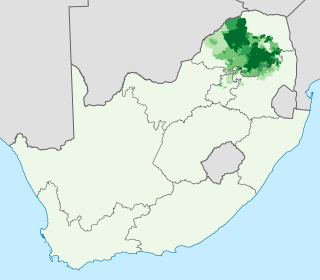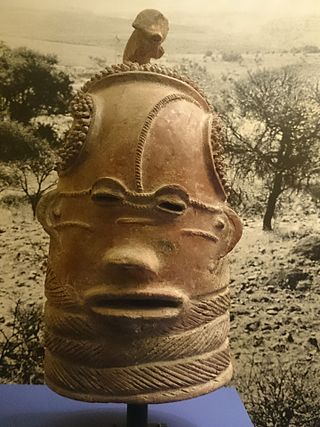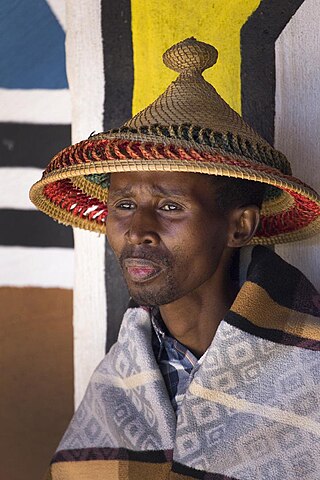
Sepedi, formerly called Sesotho sa Lebowa as an official language for the Lebowa homeland during apartheid, is a Sotho-Tswana language group spoken in the northeastern provinces of South Africa. It is commonly referred to in its standardized form as Pedi or Sepedi and holds the status of an official language in South Africa.

The coat of arms of South Africa is the main heraldic insignia of South Africa. The present coat of arms was introduced on Freedom Day, 27 April 2000, and was designed by Iaan Bekker. It replaced the earlier national arms, which had been in use since 1910. The motto is written in the extinct |Xam, member of the Khoisan languages, and translates literally to "diverse people unite". The previous motto, in Latin, was Ex Unitate Vires, translated as "From unity, strength".
SothoSesotho, also known as Southern Sotho or Sesotho sa Borwa is a Southern Bantu language of the Sotho–Tswana ("S.30") group, spoken in Lesotho, and South Africa where it is an official language;

The Sotho, also known as the Basotho, are a prominent Sotho-Tswana ethnic group native to Southern Africa. They primarily inhabit the regions of Lesotho and South Africa.
Thomas Mokopu Mofolo is considered the greatest Basotho author. He wrote mostly in the Sesotho language, but his most popular book, Chaka, has been translated into English and other languages.

Lesotho is a Southern African nation surrounded entirely by South Africa. The largest ethnic group is the Basotho. The Basotho culture is immersed in musical traditions.

At least thirty-five languages are spoken in South Africa, twelve of which are official languages of South Africa: Ndebele, Pedi, Sotho, South African Sign Language, Swazi, Tsonga, Tswana, Venda, Afrikaans, Xhosa, Zulu and English, which is the primary language used in parliamentary and state discourse, though all official languages are equal in legal status. In addition, South African Sign Language was recognised as the twelfth official language of South Africa by the National Assembly on 3 May 2023. Unofficial languages are protected under the Constitution of South Africa, though few are mentioned by any name.
Phuthi (Síphùthì) is a Nguni Bantu language spoken in southern Lesotho and areas in South Africa adjacent to the same border. The closest substantial living relative of Phuthi is Swati, spoken in Eswatini and the Mpumalanga province of South Africa. Although there is no contemporary sociocultural or political contact, Phuthi is linguistically part of a historic dialect continuum with Swati. Phuthi is heavily influenced by the surrounding Sesotho and Xhosa languages, but retains a distinct core of lexicon and grammar not found in either Xhosa or Sesotho, and found only partly in Swati to the north.
The Northern Ndebele people are a Nguni ethnic group native to Southern Africa. Significant populations of native speakers of the Northern Ndebele language (siNdebele) are found in Zimbabwe and in South Africa.

Lourens Jacobus (Louw) Wepener was born on 21 July 1812. He was the son of a German immigrant – Frederick Jacobus Wepener – and a Cape Colony woman – Johanna Maria Erasmus. Wepener was born in Graaf-Reinet and lived with his uncle – Lourens. He was christened by Reverend Andrew Murray of the Dutch Reformed Church. Wepener was first married to Hester Susanna Nel and then later to Hilletje Maria Levina Van Aardt. He had nine children with his second wife.

The coat of arms of Lesotho was adopted on 4 October 2006, after Lesotho's 40th anniversary of independence. Pictured is a crocodile on a Basotho shield. This is the symbol of the dynasty of Lesotho's largest ethnicity, the Bakoena. Behind the shield there are two crossed weapons, an assegai (lance) and a knobkierie (club). To the left and right of the shield are supporters of the shield, two Basotho horses. In the foreground there is a ribbon with the national motto of Lesotho: Khotso, Pula, Nala. The crocodile on the shield has been retained from the arms of Basutoland, the predecessor to Lesotho.

South African Bantu-speaking peoples represent the majority ethno-racial group of South Africans. Occasionally grouped as Bantu, the term itself is derived from the English word "people", common to many of the Bantu languages. The Oxford Dictionary of South African English describes "Bantu", when used in a contemporary usage or racial context as "obsolescent and offensive", because of its strong association with the "white minority rule" with their Apartheid system. However, Bantu is used without pejorative connotations in other parts of Africa and is still used in South Africa as the group term for the language family.

The following outline is provided as an overview of and topical guide to South Africa:
The Southern Bantu languages are a large group of Bantu languages, largely validated in Janson (1991/92). They are nearly synonymous with Guthrie's Bantu zone S, apart from the exclusion of Shona and the inclusion of Makhuwa. They include all of the major Bantu languages of South Africa, Botswana, Lesotho, Eswatini, and Mozambique, with outliers such as Lozi in Zambia and Namibia, and Ngoni in Zambia, Tanzania and Malawi.
The Bobirwa Subdistrict is a jurisdiction in Botswana. It is populated by the Babirwa (Ba-Birwa) people who came from Transvaal in present-day South Africa.
Several braille alphabets are used in South Africa. For English, Unified English Braille has been adopted. Nine other languages have been written in braille: Afrikaans, Ndebele, Sesotho, Northern Sotho, Swazi, Tswana, Venda, Xhosa, and Zulu. All print alphabets are restricted to the basic Latin alphabet, with diacritics in some cases; the braille alphabets are likewise basic braille with additional letters to render the diacritics.

The Basotho blanket is a distinctive form of woollen blanket commonly worn by Sotho people in Lesotho and South Africa.

Lebollo la banna is a Sesotho term for male initiation.

Lebollo la basadi also known as female initiation among the Basotho is a rite of passage ritual which marks the transition of girls into womanhood. This activity is still practiced in the Free State, Mpumalanga, Eastern Cape and KwaZulu Natal provinces of South Africa. In Sesotho, lebollo means initiation. The Basotho rite of passage ritual, unlike other practices in Africa, does not involve procedures which remove parts of the female genital organ. However, the inner folds of the labia are enlarged and elongated by stretching for a more pleasurable sexual experience. In areas where initiation is still valued, uninitiated girls are ridiculed by society.
Sesotho poetry is a form of artistic expression using the written and spoken word practiced by the Basotho people in Southern Africa. Written poetry in the Sesotho language has existed for over 150 years however, the oral poetry has been practiced throughout Basotho history.













